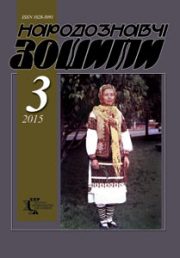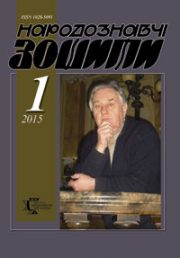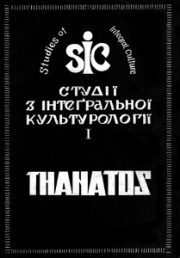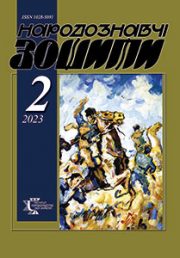The Ethnology Notebooks. 2019, № 6 (150), 1542—1550
UDK712.03-73.03
DOI https://doi.org/10.15407/nz2019.06.1542
ELEMENTS OF NATIONAL ART-AESTHETIC TRADITION IN THE PLAYGROUND SCULPTURE OF JAPAN
GLIBOVA Tatiana
ORCID ID: https://orcid.org/0000-0002-5759-3658
Lecturer in the Department of Design and Fine Arts
O.M. Beketov National University of Urban Economy in Kharkiv
17, Marshall Bazhanova st., 61002, Kharkiv, Ukraine
Contacts: e-mail: gletan.my1@gmail.com
OLENINA Olena
ORCID ID: https://orcid.org/0000-0003-4442-1192
Doctor of Arts, Professor,
Head of the Department of Design and Fine Arts
O.M. Beketov National University of Urban Economy in Kharkiv
17, Marshall Bazhanova st., 61002, Kharkiv, Ukraine
Contacts: e-mail: oleninaolena@gmail.com
Abstract. Introduction. The article analyzes Japanese play sculptures in which elements of the national artistic and aesthetic tradition were used to create original style and figurative content of the work.
Problem Statement. Looking into discussion on the prospect of the revival of children’s play sculpture, it is relevant to identify and summarize the features, character and methods of embodying the Japanese national artistic and aesthetic tradition in a purely Western European artistic invention, such as play sculpture.
Purpose. The purpose of the article is to analyze the elements of the national artistic and aesthetic tradition in the play sculpture of Japan.
Methods. The methodology of the research is based on the use of the method of comparative-historical analysis, formal-stylistic and figurative-stylistic methods, iconographic and iconological analysis, hermeneutical method.
Results. It is established that the play sculptures of Isamu Noguchi, Kuro Kaneko, Mitsuru (Man) Senda, Yayoi Kusama, Toshiko Horiuchi and Takaharu Tezuka, which are created according to modern principles of shaping, have the elements of artistic and aesthetic tradition, borrowed from the classical art of gardening, monochrome Haiga painting, graphic calligraphy school of Japanese calligraphy, etc., and also meet many of Japan’s traditional aesthetic ideals. The largest line of variations in the Japanese play sculpture «Mountain-Octopus» was created based on the popular comic character of Japanese folklore, mythology and Shinto religion, which made this sculpture a national cultural heritage.
Conclusion. In conclusion, the author points out the possibility of creating unique world-class art samples based on the synthesis of traditional national images and stylistics with contemporary art forms, an example of which is the Japanese experience of successfully adapting artistic traditions in contemporary play sculpture. The artistic experience of Japan can be an example for the creation of Ukrainian play sculpture using an authentic artistic and aesthetic tradition, original figurative and stylistic content, which will solve the problem of unification and loss of national identity in the process of globalization of the cultural world space.
Keywords: playground sculpture, national culture, Japanese artistic and aesthetic tradition, Japanese painting, graphic styling, plastic styling.
Received 29.11.2019
REFERENCES
Burkhalter, G. (2014). When playground got serious. Tate Etc. Retrieved from: https://www.tate.org.uk/tate-etc/issue-31-summer-2014/when-play-got-serious (Last accessed: 08.11.2019).
Kulanov, A.E. (2015). Attractive Japanese conservatism: genesis and transformation. Notebooks on conservatism, 5, 122—125 [in Russian].
Mostovoi, S. (2016). The evolution of the Japanese garden in the context of national history: the dissertation … Candidate of Historical Sciences: 07.00.03. Irkutsk State University [in Russian].
Bisharova, S.G. (2006). Shinto foundations of traditional Japanese culture: dis. for the study of scholars. degree of cand. Philos. Sciences: special. 24.00.01 «Theory and History of Culture» [in Russian].
Interview with Isamu Noguchi. (1973, november 7 — dec. 26). Archive of American Art; Smithsonian Institution. Retrieved from: https://99percentinvisible.org/episode/playground-mountain/ (Last accessed: 08.11.2019).
Solomon, Susan, G. (2005). American Playgroundgrounds: Revitalizing Community Space. Lebanon, NH: The University Press of New England.
Sokolov, S.N., & Murian, I.F. (Ed.). (1965). Aesthetic foundations and artistic principles of painting «haiga». Art of Japan. Digest of articles (Pp. 98—116). Moscow: The main edition of oriental literature [in Russian].
Octopus. Source: Free encyclopedia «Wikipedia». Retrieved from: https://ja.wikipedia.org/wiki/%E3%82%BF%E3%82%B3#%E7%A5%9E%E8%A9%B1%E3%83%BB%E4%BC%9D%E6%89%BF Octopus (Last accessed: 08.11.2019) [in Japanese].
Drouet, L. France. An exhibition on Japanese playgroundgrounds. crouts. Domus. Retrieved from: https://www.domusweb.it/en/news/2018/05/23/france-an-exhibition-on-japanese-playgroundgrounds.html. (Last accessed: 08.11.2019) [in French].
Maeda Environmental Art Co., Ltd. Retrieved from: http://www.e-maeda.co.jp/story/001.html. (Last accessed: 08.11.2019) [in Japanese].







